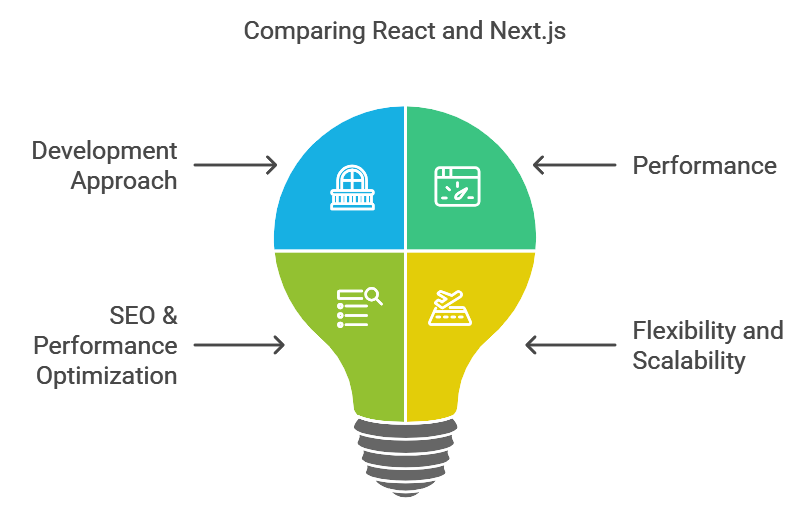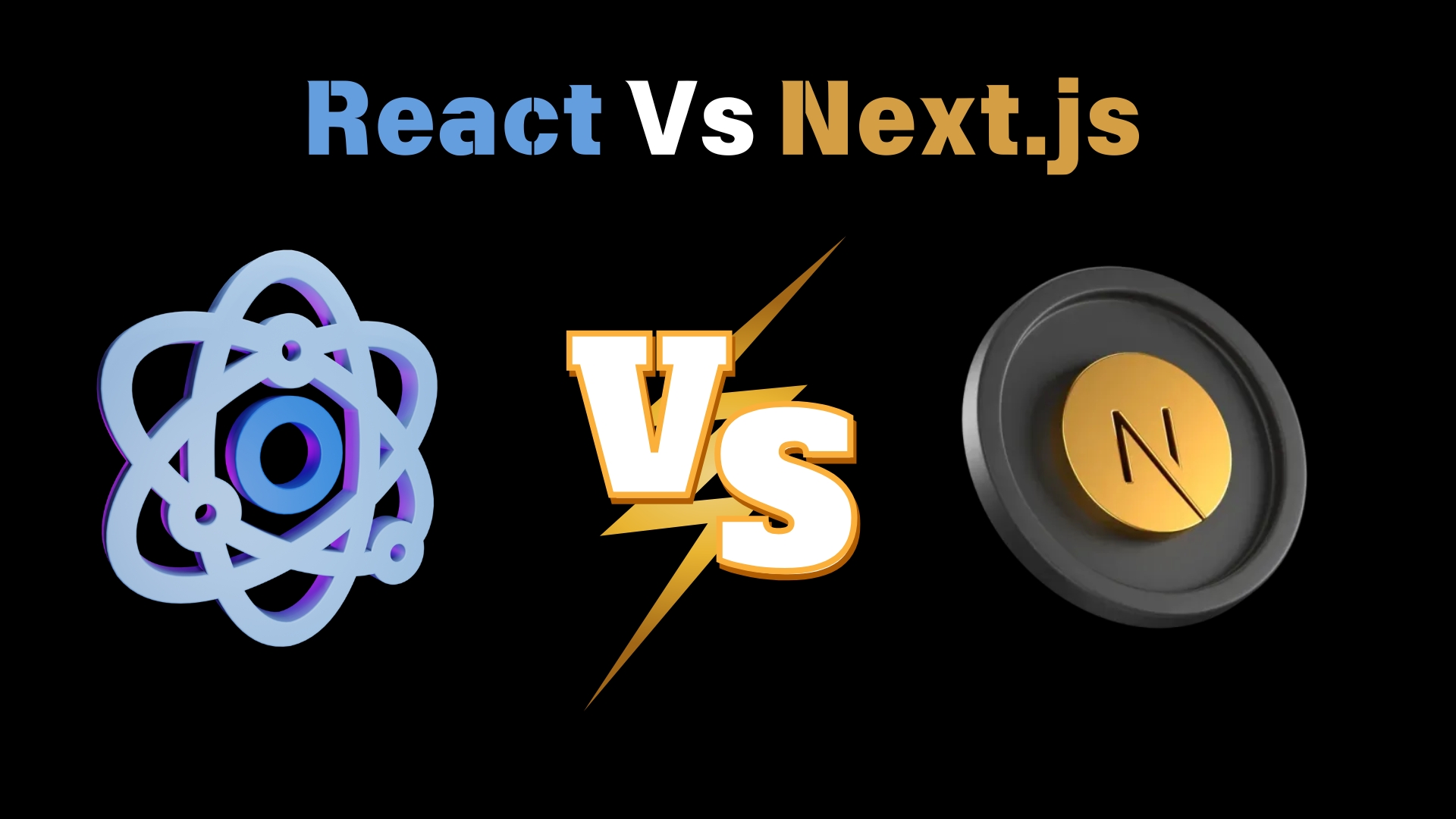When starting a new web development project, one of the pivotal decisions you must make is choosing the proper framework. For many developers, this choice often comes down to React and Next. Js—two popular technologies in the JavaScript ecosystem. But which one is best suited for your project? In this post, we’ll dive into the key differences, strengths, and use cases of React and Next.js, helping you make an informed decision.
What is React.js?
React is a powerful open-source JavaScript framework developed and maintained by Facebook. It’s widely known for building rich, interactive user interfaces, and it’s often considered the “view” in an MVC (Model-View-Controller) architecture. React’s component-based architecture allows developers to keep code organized and reusable. React primarily handles the user interface, so it’s often combined with additional libraries or frameworks for tasks such as routing, managing the application’s state, and fetching data.Some core features and benefits of React include:
- Virtual DOM: React delivers high performance using a virtual DOM, minimizing updates to the actual DOM.
- Component-based Architecture: Create reusable and modular user interface elements that can easily be integrated into bigger projects.
- Declarative UI: React makes it easy to describe and predict how your application will look using declarative programming.
- Community Support: Being one of the most popular libraries, React enjoys a vast ecosystem and strong community support.
However, React’s biggest strength, flexibility, can also become its drawback. For larger projects, developers might spend significant time configuring additional tools like Webpack, Babel, or a routing library like React Router.
What is Next.js?
Next.js is a powerful React-based framework Vercel developed that builds on React’s capabilities. It provides a complete solution for building full-fledged applications beyond just the UI. It excels at server-side rendering (SSR), static site generation (SSG), and hybrid approaches to creating modern, performant web applications.
Next.js offers many built-in features that React does not provide natively, including:
- Server-Side Rendering (SSR): Automatically render pages on the server, improving SEO and perceived performance.
- Static Site Generation (SSG): Pre-render static HTML pages at build time for rapid and scalable performance.
- API Routes: Create your lightweight backend with zero configuration needed for creating REST APIs.
- File-based Routing: Unlike React, Next.js has routing built-in with a file-based system, allowing easy page creation by adding files to the pages directory.
In other words, Next.js offers a more comprehensive out-of-the-box solution than React, making it easier to start with a full-featured application.
React vs Next.js: Key Differences
While both React and Next.js are designed to build user interfaces, they take fundamentally different approaches, which makes each better for certain types of projects. Let’s explore the key areas where React and Next.js differ.

1. Development Approach
The most significant difference between React and Next.js lies in their development approach:
– React: As mentioned earlier, React focuses solely on building dynamic UIs. It doesn’t include built-in routing or SSR. If you choose React, you must typically complement it with other libraries/tools like React Router, Redux, or Axios to handle data and routing.
– Next.js: Next.js offers a comprehensive solution, integrating features such as routing, data fetching, API routes, and performance enhancements like SSR and SSG into the framework.
React is barebones with tons of flexibility, whereas Next.js is a fully integrated solution.
2. Performance
Next.js, focusing on server-side rendering and static optimization, can significantly enhance an application’s performance, especially concerning initial load times.
– React: Since React doesn’t support SSR natively, all rendering happens on the client, which might cause longer load times, especially when dealing with large-scale applications.
– Next.js: By pre-rendering with SSR or SSG, Next.js ensures that content is delivered faster, boosting user experience and SEO performance.
If search engine optimization and fast content delivery are important, then Next.js could be the better choice.
3. SEO & Performance Optimization
For web applications where search engine optimization (SEO) is crucial, Next.js has a significant advantage thanks to its server-side capabilities:
– React: React applications usually run entirely on the client side. Due to this, bots and crawlers may need help indexing the content thoroughly.
– Next.js: Server-side rendering (SSR) in Next.js allows search engines to crawl a fully rendered page, improving SEO. Static Site Generation (SSG) also delivers faster loading times, enhancing the search engine ranking.
If SEO is a crucial consideration, Next.js might be your project’s most suitable framework.
4. Flexibility and Scalability
– React: React is highly flexible and can be combined with other libraries to create a starting point for any web application. Scaling a React application can get complicated when more layers of tools and configurations are added.
– Next.js: While Next.js offers many built-in functionalities, it’s more flexible than React. It excels in standard use cases like e-commerce stores, blogs, or corporate websites. However, if you wish to move away from the typical Next.js patterns, using React may give you more flexibility, letting you have better control over both design and functionality.
When to Use React
React shines when you want to:
- Build highly interactive and content-dense UIs on the client side.
- Have complete flexibility and control over libraries and tools used in your project’s architecture.
- Integrate with backend services like Firebase, AWS Amplify, or platforms that handle SSR needs elsewhere.
- Work on complex state management libraries like Recoil, Zustand, or Redux.
If your project is dynamically interactive, needs heavy client-side control, or will scale over time with multiple modular parts, React might be the right choice.
When to Use Next.js
Next.js is a great option when you:
- Need SEO-friendly content and fast loading times due to Server-Side Rendering (SSR) or Static Site Generation (SSG).
- Want to start quickly with built-in routing, API handling, and other tooling?
- Are building marketing sites, blogs, or eCommerce applications that demand stellar SEO performance?
- I only want to spend time configuring a few third-party tools.
Next.js is ideal for projects where performance, SEO, and fast deployment are more important than total flexibility.
Conclusion: Which One is Right for You?
Choosing between React and Next.js ultimately depends on your project’s unique needs:
– React is a flexible and powerful library for building dynamic applications requiring full-stack control.
– On the other hand, Next.js simplifies the development process by offering essential built-in features like SSR, SSG, and API routes, making it an excellent choice for projects centered around performance, SEO, and out-of-the-box solutions.
Both technologies are valuable additions to a developer’s toolkit. If you’re looking to develop fast, performative applications, Next.js is your go-to framework. However, if flexibility and custom architecture are essential for your project, React offers endless possibilities.







